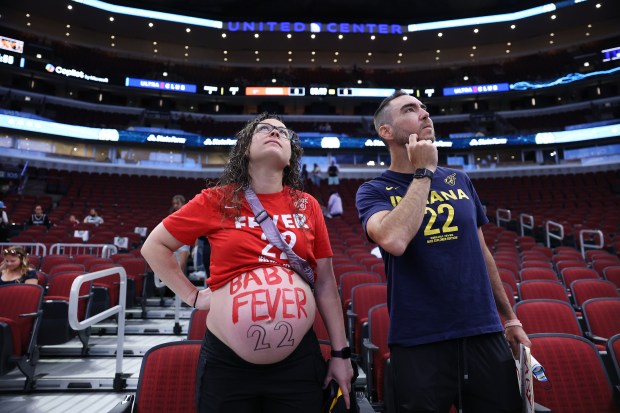Donald Trump shattered the “Blue Wall” of states that Democrats had counted upon to keep the White House as he declared victory early Wednesday on his way to becoming the 47th president of the United States.
Illinois remained an exception as the former Republican president defeated Democratic Vice President Kamala Harris in Pennsylvania, and held leads in both Michigan and Wisconsin as ballots continued to be counted in the early morning hours Wednesday.
The path for Harris to gain the 270 electoral votes needed to win the White House had relied exclusively on the “Blue Wall” states. That path had become more narrow as she lost the two Sun Belt battleground states of Georgia and North Carolina that also were critical to President Joe Biden’s 2020 win over Trump.
Trump claimed victory shortly before 1:30 a.m. Wednesday at a campaign rally in West Palm Beach, Florida in a speech that veered from thanking voters to recounting his awe over the return of Elon Musk’s SpaceX rocket while also hailing PGA U.S. Open champion Bryson DeChambeau.
“This was a movement like nobody’s ever seen before, and frankly, this was, I believe, the greatest political movement of all time. There’s never been anything like this in this country, and maybe beyond. And now it’s going to reach a new level of importance, because we’re going to help our country,” Trump said. “It’s time to put the divisions of the past four years behind us. It’s time to unite.”
Shortly before midnight, Cedric Richmond, the co-chair of Harris’ campaign, told supporters at Howard University in Washington that the campaign would continue “to fight to make sure that every vote is counted and every voter has spoken.”
Richmond said Harris on Wednesday would “not only address her supporters, but address the nation,” raising speculation of a concession from the first Black and Asian American female presidential nominee of a major political party.
In contrast to the other “Blue Wall” states, the Associated Press quickly called the outcome for Illinois, only 38 minutes after polls in the state closed at 7 p.m. Tuesday. A reliably blue state in presidential contests since it went for Bill Clinton over reelection-seeking President George H.W. Bush in 1992, Illinois was never considered in play by the Trump campaign.
With 90% of the state’s estimated votes counted, Harris led Trump in Illinois 53% to 45%. Robert F. Kennedy Jr., who remained on Illinois’ ballot even though he dropped his independent bid and endorsed Trump, received 1% of the vote.
Trump lost the previous two presidential contests in Illinois, in 2020 and 2016, by 17 percentage points. But he apparently halved that differential in Illinois, making it the closest White House contest in the state since Democrat John Kerry defeated President George W. Bush in the state by 10% in 2004, though Bush won reelection nationwide.
Before any ballots were counted, Illinois Gov. JB Pritzker, long a major national Democratic donor and a surrogate for Biden and then Harris, praised the state Democratic Party and party activists for their work at home and in Wisconsin and Michigan to encourage turnout.
“Elections matter and we are making sure that we have the infrastructure here in Illinois to get that message out to voters — from the top of the ticket all the way down the ballot,” Pritzker said. “I hope every Illinoisan who knocked doors, made phone calls, got friends and family to vote and maybe even ran for office themselves is proud of the work they put into this election. Their dedication will make a difference in the future of Illinois and this country.”
Now Democrats in Illinois, and across the nation, may look to reevaluate the party, its progressivism and its ability to relate to the blue collar voters that were once its lifeblood, in the face of national GOP victories that included Republicans retaking the U.S. Senate.
The results also may have Pritzker evaluating a future White House bid after he launched a national group backing state abortion rights initiatives. Pritzker had been on Harris’ short list for a running mate before selecting Minnesota Gov. Tim Walz.
Pritzker had repeatedly emphasized that “The ‘Blue Wall’ is vitally important,” not just for Democrats but for Republicans.
“I think they are vitally important for either side,” he said a week before Election Day. “To be honest, I think it’s good that everybody’s a little on edge, on both sides probably. Having more people vote is better for the country.”
More than just battleground states, Pennsylvania, Wisconsin and Michigan could truly be considered swing states. They backed President Barack Obama’s election in 2008 and reelection in 2012 before swinging to Trump in 2016 and then swinging back to Biden four years later.
With no major races in Illinois and its presidential contest not in doubt, Illinois’ proximity to Wisconsin and Michigan made both states targets for active campaigning by the state’s Democratic leaders and party activists.
Like Illinois, which has seen its once-Republican rich collar counties morph from red to purple amid changing demographics and a moderate social ideology that conflicts with the GOP’s growing far-right stances, the presidential race looked to be decided in the suburbs of Philadelphia and Pittsburgh, Detroit and Milwaukee.
Early Wednesday morning, the Associated Press declared Trump had won Pennsylvania. With 95% of the expected vote counted, Trump was leading Harris 51% to 48%. In Michigan, Trump had a 53% to 46% advantage over Harris with 73% of the expected vote tallied. And in Wisconsin, Trump led Harris 51% to 47% with 90% of the expected ballots counted.
Shortly after 10 p.m. on Tuesday, Harris campaign manager Jen O’Malley Dillon sent an email to campaign staff that as campaign staff watched results “from the Sun Belt states, we have known all along that our clearest path to 270 electoral votes lies through the Blue Wall states. And we feel good about what we’re seeing.”
Pennsylvania’s 19 electoral votes were considered the big prize among the “Blue Wall” states, a fact reflected by both the frequency of Harris’ and Trump’s visits as well as the huge amount of campaign cash pumped into the state for advertising.
In 2016, Trump defeated Hillary Clinton in the state by 44,292 votes or 0.72%. Four years later, Biden defeated Trump by 80,555 or 1.16%.
In Wisconsin, the battle was over the state’s 10 electoral votes following extremely right contests in the previous two presidential elections.
In 2016, Trump won Wisconsin by a scant 22,748 votes, or 0.77%. Four years later, Biden won the state by an even closer margin, 20,682 votes or 0.62%.
Harris and Trump collectively made more than 30 visits to the state, its role in the presidential election still substantial even though it has the fewest number of electoral votes among the “Blue Wall” states.
In Michigan, with its 15 electoral votes, campaigning focused on Detroit and the suburbs of Wayne, Oakland and Macomb counties, as well as Grand Rapids and suburban Kent County and Ann Arbor and suburban Washtenaw County.
Trump took Michigan in 2016 by a minuscule 10,274 votes, or 0.23%, while Biden won by a larger spread over Trump in 2020, 154,188 votes or 2.8%.




